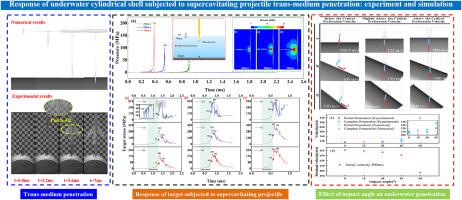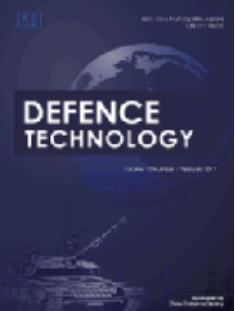Response of underwater cylindrical shell subjected to supercavitating projectile trans-medium penetration: Experiment and simulation
IF 5.9
Q1 ENGINEERING, MULTIDISCIPLINARY
引用次数: 0
Abstract
To investigate the dynamic response of the cylindrical shell targets to supercavitating projectile trans-medium penetration and the penetration mechanism, experiments and numerical simulations were conducted. Simulations examined the effects of entry water velocity and impact angle on penetration behavior. The results indicate that, upon water entry, the supercavitating projectile transfers its kinetic energy to the surrounding water medium, causing a sudden rise in local pressure. This creates an approximately hemispherical pressure field in the water medium ahead of the nose of the projectile, where the pressure distribution and magnitude are positively correlated with the velocity of the projectile. As the pressure field approaches the cylindrical shell, the area around the impact point experiences pre-stress and deformation due to the hydrodynamic pressure, which is known as the hydrodynamic ram effect. The deformation of the cylindrical shell caused by the hydrodynamic ram effect increases with increasing velocity of the projectile and exhibits a non-linear relationship with the impact angle, first decreasing and then increasing as the impact angle rises. Additionally, the hydrodynamic ram effect leads to greater local deformation and higher peak stresses in the cylindrical shell, which reduces the penetration drag force faced by the projectile in water compared to air, indicating a lower ballistic limit for underwater targets. During the penetration process, as the impact angle increases, the supercavitating projectile undergoes repetitive bending deformation and even brittle fracture, while the failure mode of the target is characterized by ductile hole expansion. Furthermore, the critical penetration velocity required to perforate the cylindrical shell target increases with increasing impact angle.

超空泡弹丸跨介质侵彻水下圆柱壳的响应:实验与仿真
为研究超空泡弹跨介质侵彻对圆柱壳靶的动力响应及其侵彻机理,进行了实验和数值模拟。模拟测试了进入水流速和冲击角对侵彻行为的影响。结果表明,超空泡弹丸入水后,将其动能传递给周围的水介质,引起局部压力的突然升高。这在弹鼻前方的水介质中产生了一个近似半球形的压力场,其中压力分布和大小与弹丸的速度呈正相关。当压力场接近圆柱壳时,由于动水压力的作用,冲击点周围的区域发生了预应力和变形,称为动水冲击效应。水动力撞击效应引起的圆柱壳变形随弹丸速度的增大而增大,与冲击角呈先减小后增大的非线性关系。此外,水动力撞击效应导致圆柱壳的局部变形更大,峰值应力更高,这使得弹丸在水中所面临的突防阻力比在空气中要小,这表明水下目标的弹道极限更低。在侵彻过程中,随着冲击角的增大,超空泡弹丸发生反复弯曲变形甚至脆性断裂,靶体的破坏模式以韧性孔洞扩张为特征。此外,随着冲击角的增大,射孔圆柱壳靶所需的临界侵彻速度也随之增大。
本文章由计算机程序翻译,如有差异,请以英文原文为准。
求助全文
约1分钟内获得全文
求助全文
来源期刊

Defence Technology(防务技术)
Mechanical Engineering, Control and Systems Engineering, Industrial and Manufacturing Engineering
CiteScore
8.70
自引率
0.00%
发文量
728
审稿时长
25 days
期刊介绍:
Defence Technology, a peer reviewed journal, is published monthly and aims to become the best international academic exchange platform for the research related to defence technology. It publishes original research papers having direct bearing on defence, with a balanced coverage on analytical, experimental, numerical simulation and applied investigations. It covers various disciplines of science, technology and engineering.
 求助内容:
求助内容: 应助结果提醒方式:
应助结果提醒方式:


